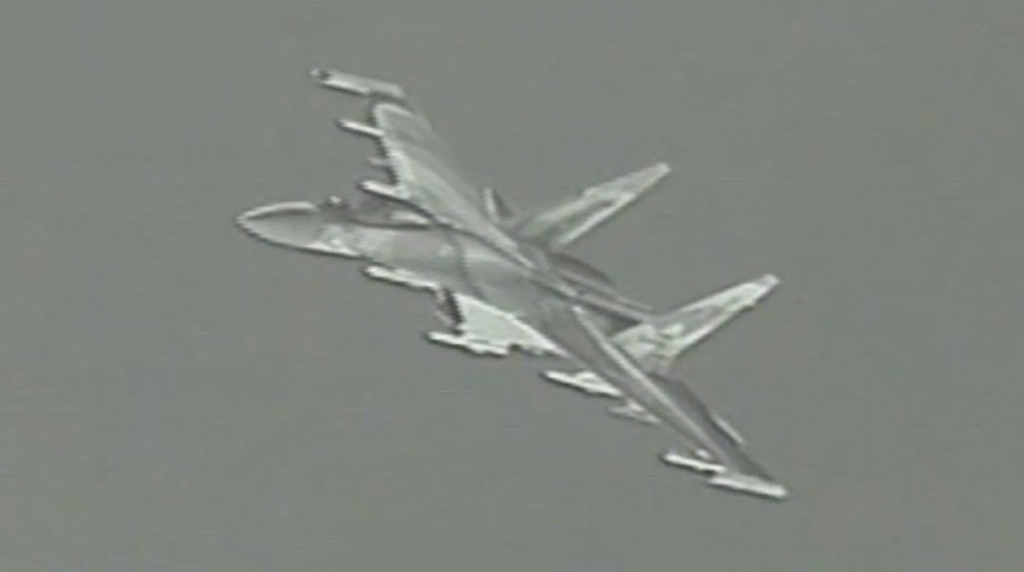The Russian aircraft are aggressively maneuvering against U.S. fighters during close encounters in the skies over Syria.
Earlier this month, the U.S. Air Force Central Command released footage of an unsafe and unprofessional intercept conducted by a Russian Su-35 jet on a U.S. F-16 over Syria. The clip, shot by the American aircraft using a targeting pod on Apr. 2, 2023, shows the armed Flanker-E aggressively maneuvering while interacting with the “Viper” (as the F-16 is nicknamed in the fighter pilot community).
“The aircraft were operating in airspace that US-Russian protocols recognize as Coalition-controlled airspace over Syria. The Russian Su-35 had not been deconflicted when it entered the airspace. This incident follows a pattern of dangerous actions by Russian pilots while interacting with U.S. and Coalition aircraft. These aggressive actions by Russian aircrew demonstrate lack of competence and could lead to miscalculation and unintended escalation,” the official caption says.
Another declassified IR (Infra-Red) footage released by U.S. CENTCOM shows a Russian Su-35 that violated Coalition Force airspace in Syria on Apr. 18, 2023. As a consequence of the violation, “U.S. Air Force fighter aircraft took off from air bases in the region and intercepted the Russian fighter. During the intercept, the Russian pilot maneuvered unprofessionally within 2,000 feet of U.S. aircraft, violating standing deconfliction protocols.”
In a public release that accompanied the two declassified videos, Lt. Gen. Alexus Grynkewich, 9th Air Force (Air Forces Central) Commander said that Russian overflights of the OIR area of operations are of particular concern.
Armed Russian fighter aircraft flew over U.S. and coalition positions 26 times from March 1 to April 19 (the date when the release was published). “Over the course of my career I have not seen this kind of disregard for agreed upon protocols and deconfliction rules,” he said, which includes a 34-mile deconfliction zone around a coalition base near At Tanf and a hotline to discuss and prevent potential issues. In 2019 protocols were established between the U.S.-led Coalition and Russia to avoid miscalculations and potentially dangerous encounters in airspace over Syria.
Until Apr. 19, Russian aircraft had violated the deconfliction protocols 63 times.
“We’ve seen Russian aircraft come within 500 feet of our aircraft,” said Grynkewich. “As a professional air force, we will do everything in our power to ensure we maintain safety of flight and engage according to our special instructions. However, if any entity threatens the safety and security of coalition forces in the sky or on the ground, we will take swift action to address the threat.”
As reported by DefenseOne, in a more recent interview, Grynkewich added: “They’re maneuvering aggressively against us when our protocols would say we’re supposed to stay… several miles apart and just monitor each other. [T]hey’re aggressively maneuvering, almost like they’re trying to dogfight, if you will.” “That’s very concerning.”
Needless to say, the concern is that these interaction may lead to something more serious, like the collision over the Black Sea that involved a U.S. MQ-9 that led to the loss of the Reaper in March or the “near-shoot down” of a British Rivet Joint during an intercept occurred on Sept. 29, 2022, over the Black Sea.
While the Russians don’t want to really engage U.S. fighters or dogfight with them, these close encounters have an inherent risk of miscalculation and escalation, hence the guidance of the U.S. general to his pilots is “to act in a professional manner, and we’re going to try to de-escalate the situation.” His message is: “Don’t take the bait”, according to DefenseOne.













